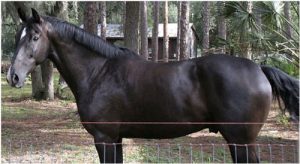Very little can be done about the genetic predisposition, which places the dorsal spines a little too close, but a horse can learn to work and functions efficiently with this genetic abnormality. The key is to identify the posture and working attitude causing intermittent contact of the dorsal spines. The horses that we have reeducated presented all a combination of stiffening or arching of the thoracolumbar spine, associated with a problem of lateral bending and/or transversal rotation.
Once the source of the kinematic abnormality has been identified, the reeducation is in fact an education. The therapy for kissing spine can be summarized as educating the horse to live with his problem. The horse learns to function efficiently adopting a vertebral coordination avoiding closing of the dorsal spines.
Once the source of the kinematic abnormality has been identified, the reeducation is in fact an education. The therapy for kissing spine can be summarized as educating the horse to live with his problem. The horse learns to function efficiently adopting a vertebral coordination avoiding closing of the dorsal spines.






